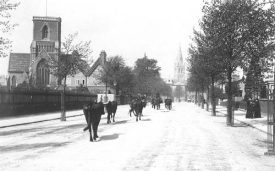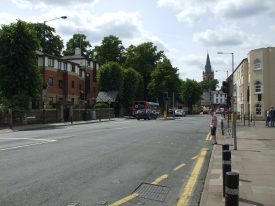Holy Trinity church was opened in 1854 as a Chapel-of-Ease to St. Andrew’s, building work having started in 1852. The total cost was £7,250. Designed by Sir George Gilbert Scott, famed for his Gothic revival style and his prolific contribution to church design, the Architect’s drawings for the building include one for a spire. This spire was never built however, owing to the ground on which the church stood not being firm enough. The opening service on April 20th was a great event, and the Rugby Advertiser of 6th May 1854 reported how the church was “one of the most splendid specimens of the early decorated style of architecture of the 19th century.”
The opening of the church
The Advertiser also mentioned how a large crowd of people came to witness the ceremony. This crowd brought with it some problems. One Matthew Lowe wrote to the paper complaining that a policeman refused him entry, and took umbrage at being called an “obstinate fellow.”1 Over the coming weeks, there followed correspondence between Lowe and ‘a policeman’ where the policeman claimed their instructions “were to keep as strict order as possible, to admit everybody who wanted to attend the service, but not those who just wanted to look around out of curiosity.” The policeman claimed that “Mr Lowe came blustering forward… in opposition to reason or resistance, without stating whether he intended to go into church or lurk round the entrance.”2 Lowe again, was keen to deny he was ‘blustering’ or ‘lurking’!
Closure
The church closed in 1974, and was controversially demolished in 1983, with the site being used for retirement flats. The lych gate survives, and is dedicated to members of the congregation who were victims of the Great War. The dedication service was held on June 23rd 1921.
1. Rugby Advertiser April 29th 1854.
2. Rugby Advertiser May 6th 1854.









Comments
The organ case and the chancel screen from Holy Trinity, Rugby, were removed in 1982 to All Saints’ Church, Leamington, where they can still be seen. The organ case is now above the console in the chancel, and the screen forms the front of the Urquhart Room at the west end of the nave.
Yet more memories triggered! When attending Lawrence Sheriff School in Rugby 1941-1946, a good friend was J.K. (Jake) Watson who lived in Eastfield Place (I think), where I would sometimes call for him on the way from my home in Charles Street. We would cut through Holy Trinity churchyard with its table tombs to school. I dream several times every night, and some 30 years ago I had my only coloured dream; it was set in this churchyard in lovely sunshine with butterflies all around.
Do you remember Rodney Huntingford, the photographer, front left of the gate, and the public toilet ahead? Opposite was the row of old converted houses, one of which was a fish-and-chip shop where we ate meat pies with chips and gravy in the always steamy upstairs room instead of dull school dinners.
Edward..
I have a table top made from pieces of the parquet flooring of the nave, they were all being burnt with other demolition waste.
I was the head choirboy at Holy Trinity Church Rugby from 1967 under organist and choirmaster Roy Young. While there I learnt to play the excellent three-manual “Forster and Andrews” organ, which had casework by the well-known architect George Frederick Bodley (some of the casework was moved to All Saints Leamington Spa, as noted above).
I was then the last organist and choirmaster at the church from 1973 to 1974 when the church closed.
I am now an organist in a large church in West London.
What a terrible shame that such a lovely church should be demolished. Claude Blagden, Rector of Rugby 1912-1927 and later Bishop of Peterborough, wrote about this church in his memoirs “Well Remembered” (1953). He would be appalled that Holy Trinity (and the beautiful old Rectory to the south of St Andrew’s Church) have been pulled down. Thank goodness the lychgate at Holy Trinity has been preserved – it commemorates the men of the parish who fell in the Great War, and also the curate-in-charge, the Revd Dick Dugdale, who was killed just six weeks before the Armistice. Lest we forget.
Add a comment about this page